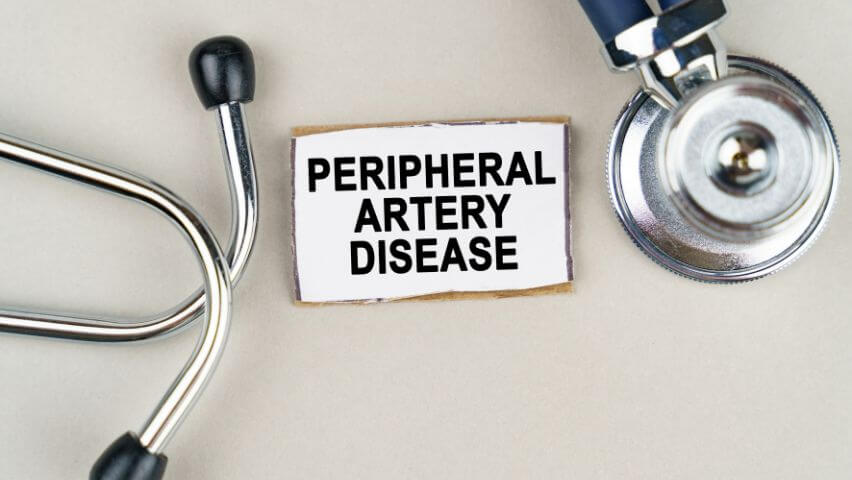Medical Term for PAD
If you or someone you love is dealing with peripheral artery disease (PAD), you might feel overwhelmed by the new terms you have to learn. It’s understandable—PAD medical terms can sound like they’re from another language. In a way, they are. But you’re not on your own. The team at USA Vascular Centers is here to help you navigate every step of your PAD journey.
The first step is gaining an understanding of PAD medical terms. This guide covers the terms you’ll need to know as you learn more about this vascular disease, including intermittent claudication, atherosclerosis, and angioplasty. If you’re concerned you may have PAD, reach out to our caring team of providers to set up an appointment. Our vascular doctors are highly skilled in diagnosing and treating PAD.
What Is PAD in Medical Terms?
PAD is short for peripheral artery disease, a vascular condition that affects the arteries leading to your lower limbs. PAD is caused by plaque accumulation in the arteries. When plaque builds up to the point that blood can’t efficiently flow through the arteries, a patient has PAD. This condition is more common in people over age 60; however, it can also affect younger people, especially if they live with PAD risk factors like smoking, diabetes, or high cholesterol.
It’s important to seek diagnosis and treatment for PAD as soon as you notice symptoms. Common symptoms of PAD include leg pain after walking a short distance, a noticeable loss of leg hair, and open sores that don’t heal. If you’ve already received a diagnosis, contact USA Vascular Centers today to learn about your treatment options.
Other PAD Medical Terms to Know
Our glossary will help you understand the language your medical team may use to describe PAD in medical terms. Check this glossary anytime you have a doctor’s appointment coming up or simply want to understand more about PAD medical terms.
Angioplasty
Angioplasty is a minimally invasive medical procedure that helps open up space for blood to flow through clogged arteries. Angioplasties are typically performed in a catheterization (or “cath”) lab. During an angioplasty, an interventional radiologist or vascular doctor makes a small incision in the groin and guides a thin tube, called a catheter, into the patient’s vascular system.
This special catheter has a deflated balloon attached near the tip. The vascular specialist guides the catheter to a blocked artery and inflates the balloon, compressing the plaque against the walls of the artery. This widens the space inside the artery, allowing blood to flow more freely through the vascular system.
Ankle Brachial Index
Providers often use an ankle-brachial index (ABI) test to see if a patient has abnormal blood flow in the legs due to PAD. In this test, a provider uses a blood pressure cuff and a handheld Doppler ultrasound machine to measure the blood pressure in a patient’s arm and ankle.
Comparing these measurements results in a numerical value that helps determine whether a patient might have PAD.
Atherectomy
Atherectomy is a minimally invasive procedure that uses a blade or laser to cut or vaporize plaque from the artery wall. Atherectomies are performed in a cath lab.
A vascular doctor or interventional radiologist threads a blade- or laser-tipped catheter into the vascular system, usually through a small incision in the groin. The plaque is then pulverized or cut and safely removed from the body.
Atherosclerosis
Atherosclerosis is the PAD medical term for plaque buildup in the arteries. Plaque is made up of cholesterol, fat, cell waste products, calcium, and fibrin (a protein that helps clot blood) and can start accumulating in the arteries during childhood.
Over time, plaque buildup can worsen if a person is dealing with certain risk factors. These include a genetic predisposition to atherosclerosis, high cholesterol, smoking, high blood pressure, older age, and diabetes.
Almost everyone experiences plaque buildup in the arteries by the time they are 60 years old or older. That’s why we recommend getting screened for PAD once you’ve reached age 60. If you live with other PAD risk factors, we encourage you to get screened earlier in life.
For people with atherosclerosis, plaque has accumulated to the point that it congests the arteries. Blood has a hard time flowing through the arteries as it should, which leads to reduced circulation to the legs and feet.
If someone has atherosclerosis in the arteries leading to their legs and feet, they most likely have it in the arteries leading to the heart and brain, too. This increases the risk of heart attack and stroke.
Getting treatment for atherosclerosis can help slow the progression of arterial disease. If you live with any risk factors for atherosclerosis, a simple screening test can help you get started on the road to treatment.
Claudication
Claudication is a medical term for PAD-related pain in the legs. When atherosclerosis causes reduced blood flow to your lower limbs, the muscles in your legs can’t get the oxygen and nutrients they need to function properly. They start to cramp up, causing the pain we call claudication.
If claudication only happens when you’re doing an activity like walking around the block or climbing a flight of stairs, it’s called intermittent claudication. Intermittent claudication pain goes away once you sit down and rest. This is the most common symptom of PAD.
Without treatment, intermittent claudication eventually turns into constant pain that doesn’t go away, even when resting. This indicates that your legs aren’t getting enough oxygen to function and is a sign of critical limb ischemia.
Critical Limb Ischemia (CLI)
In PAD medical terms, critical limb ischemia occurs when the blood flow to one of your lower limbs or feet is almost completely blocked. Your toes, feet, or legs will hurt constantly, making any type of movement difficult.
You may also notice open sores that don’t heal, shiny skin on your feet or legs, or thick, slow-growing toenails. CLI is a sign that the affected limb is dying. Without treatment, critical limb ischemia will always lead to the need for amputation.
Ultrasound
Ultrasounds use sound waves to produce images of what’s going on inside your body. A Doppler ultrasound, for example, can detect movement within the body. Vascular doctors often use a Doppler ultrasound to look at how blood flows through your vascular system, which helps them diagnose PAD.
Schedule an Appointment with USA Vascular Centers
Are you concerned you may have PAD? Take our PAD risk assessment quiz or schedule an appointment to meet with one of our providers. Living with PAD doesn’t have to be confusing. Call USA Vascular Centers today—we’re here to help you every step of the way.

